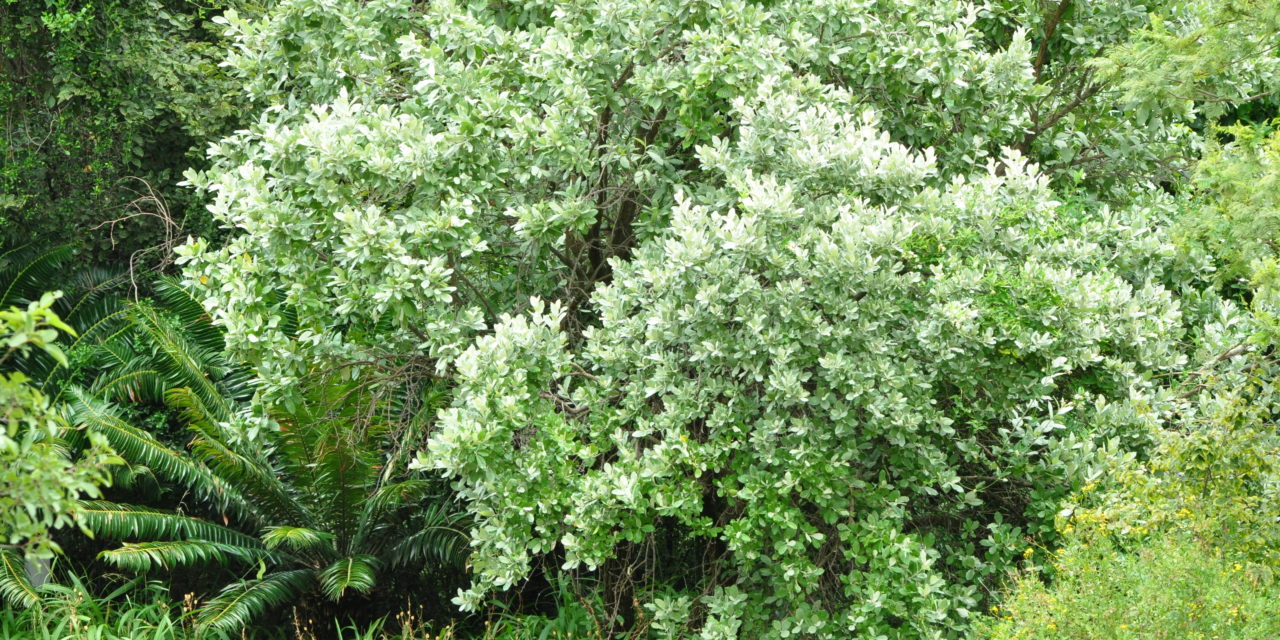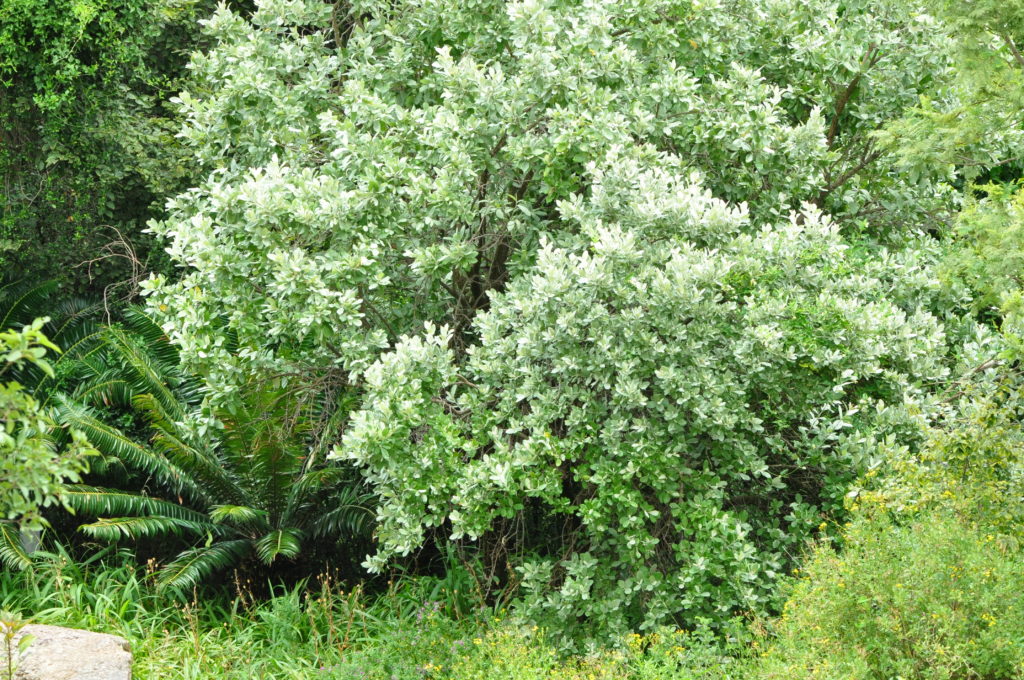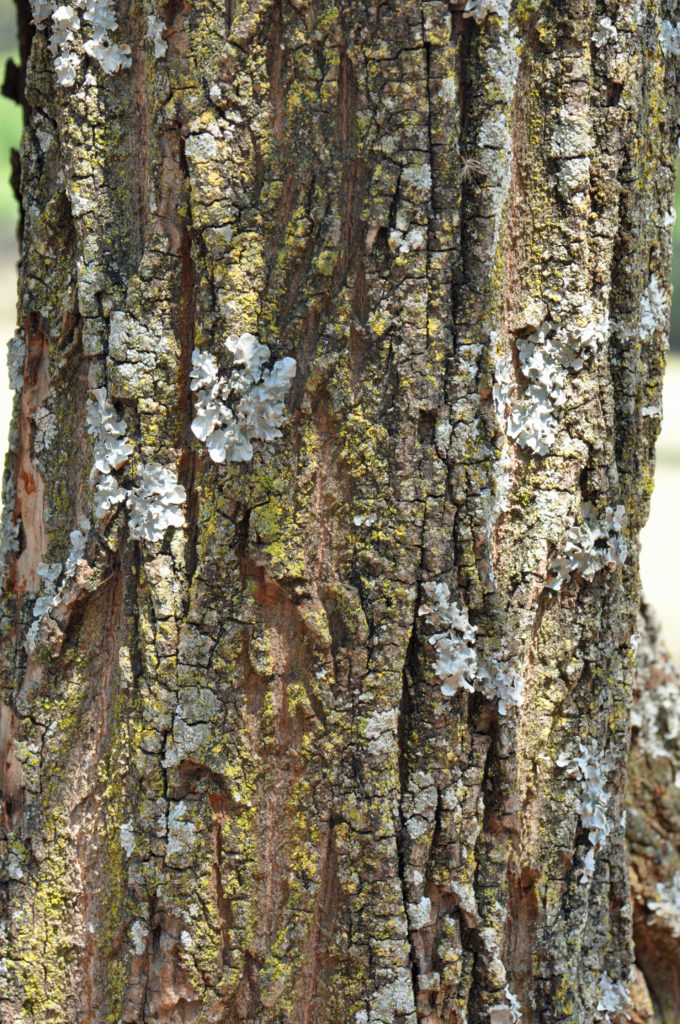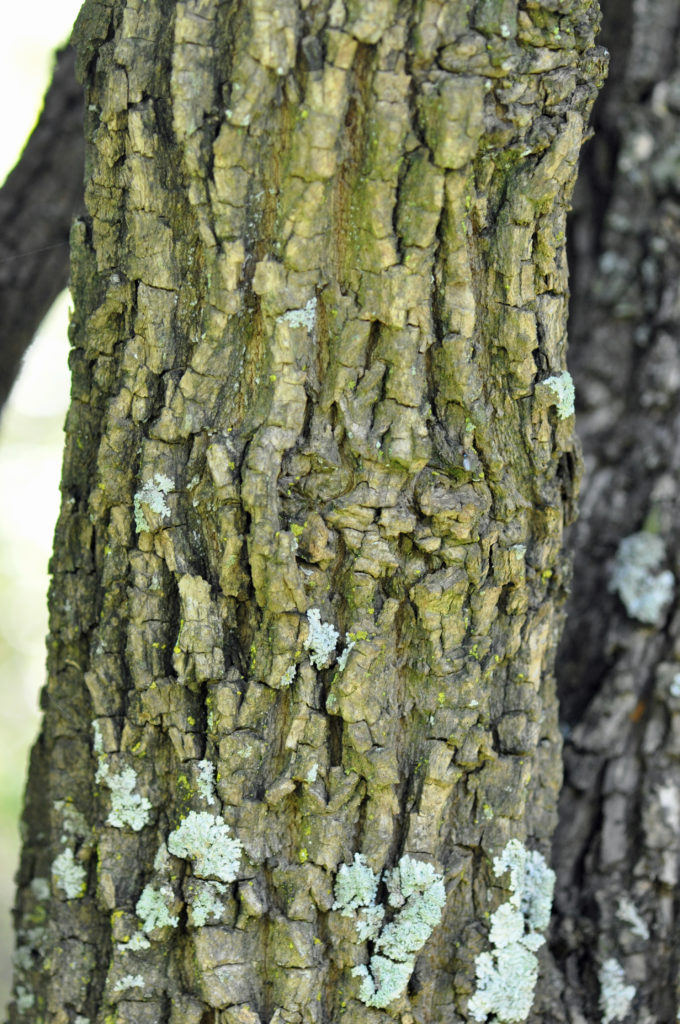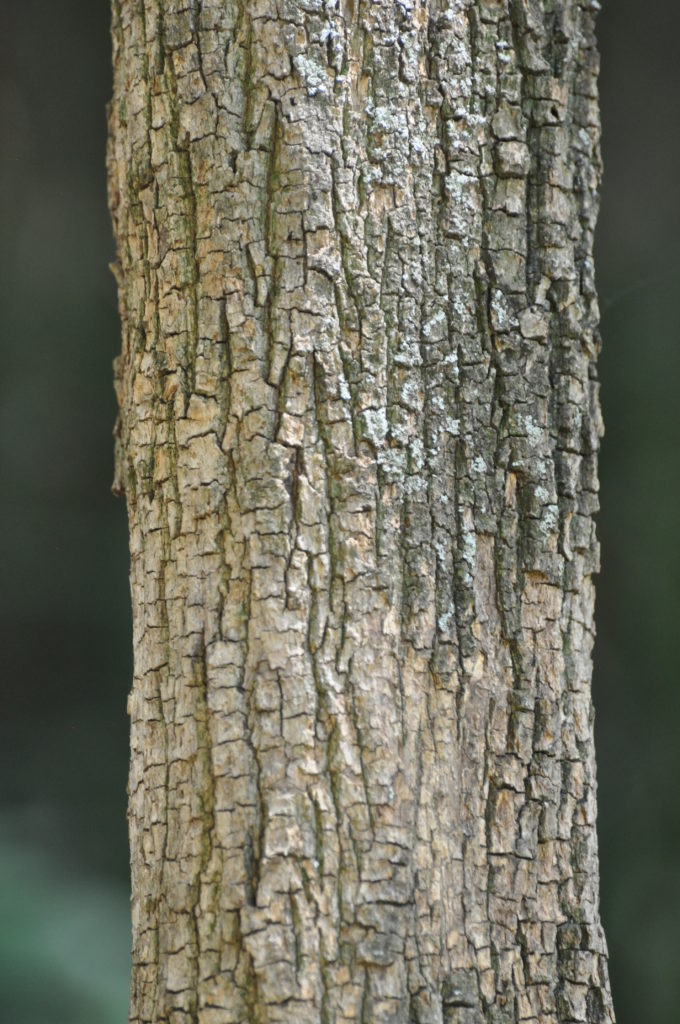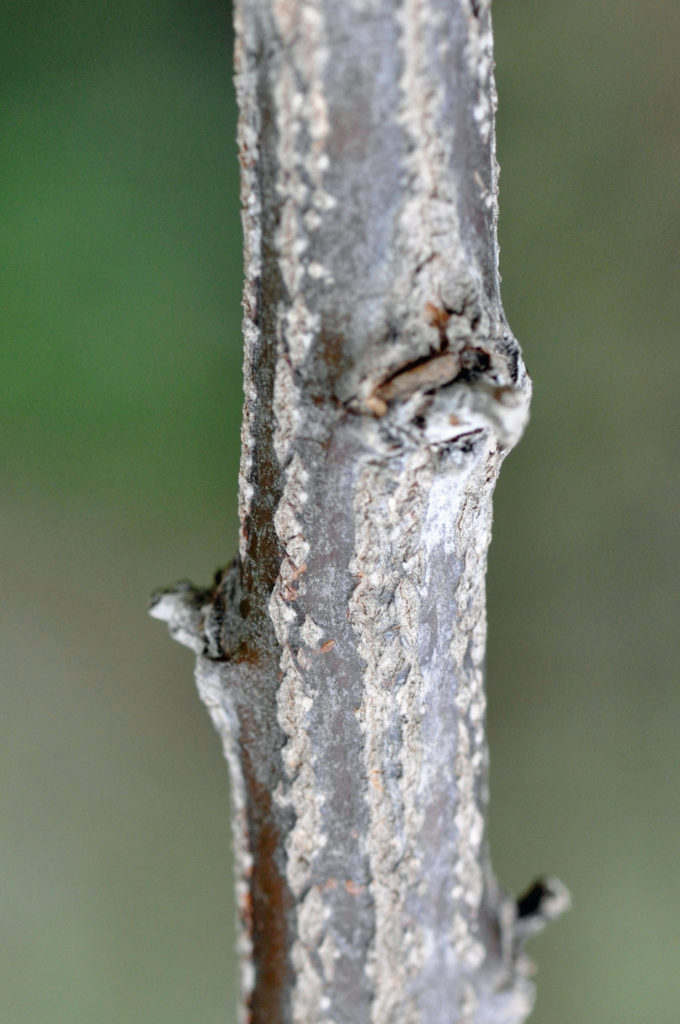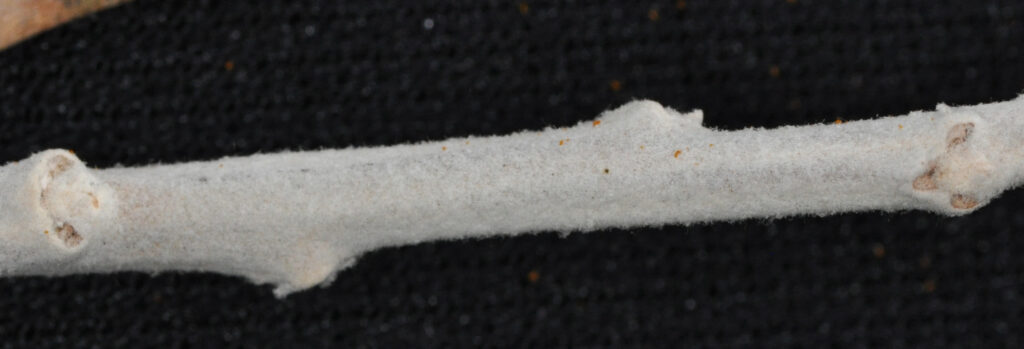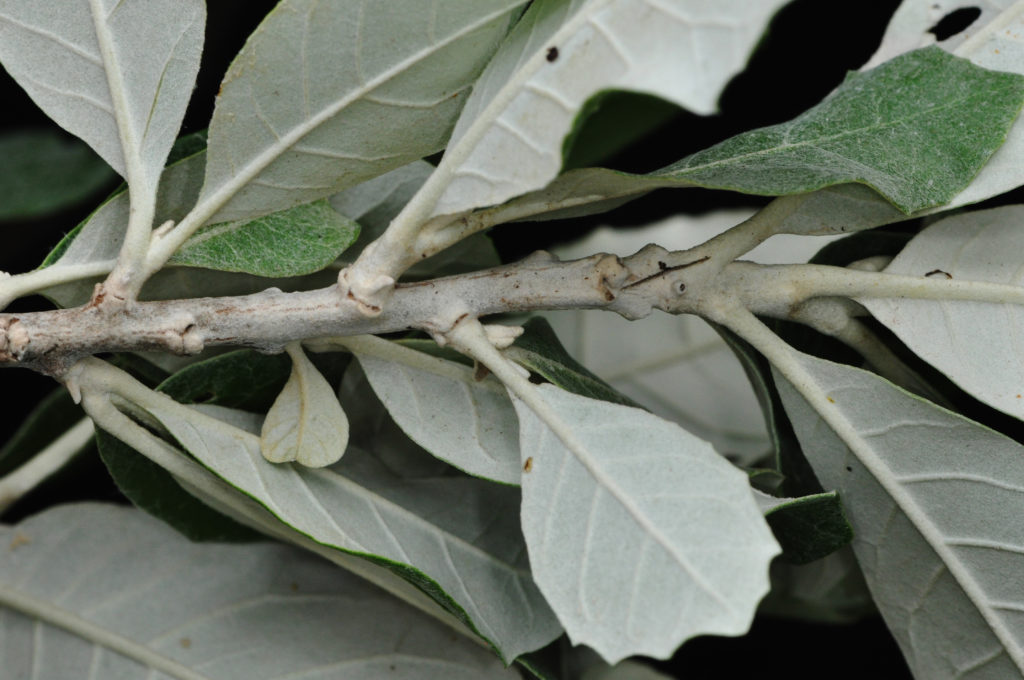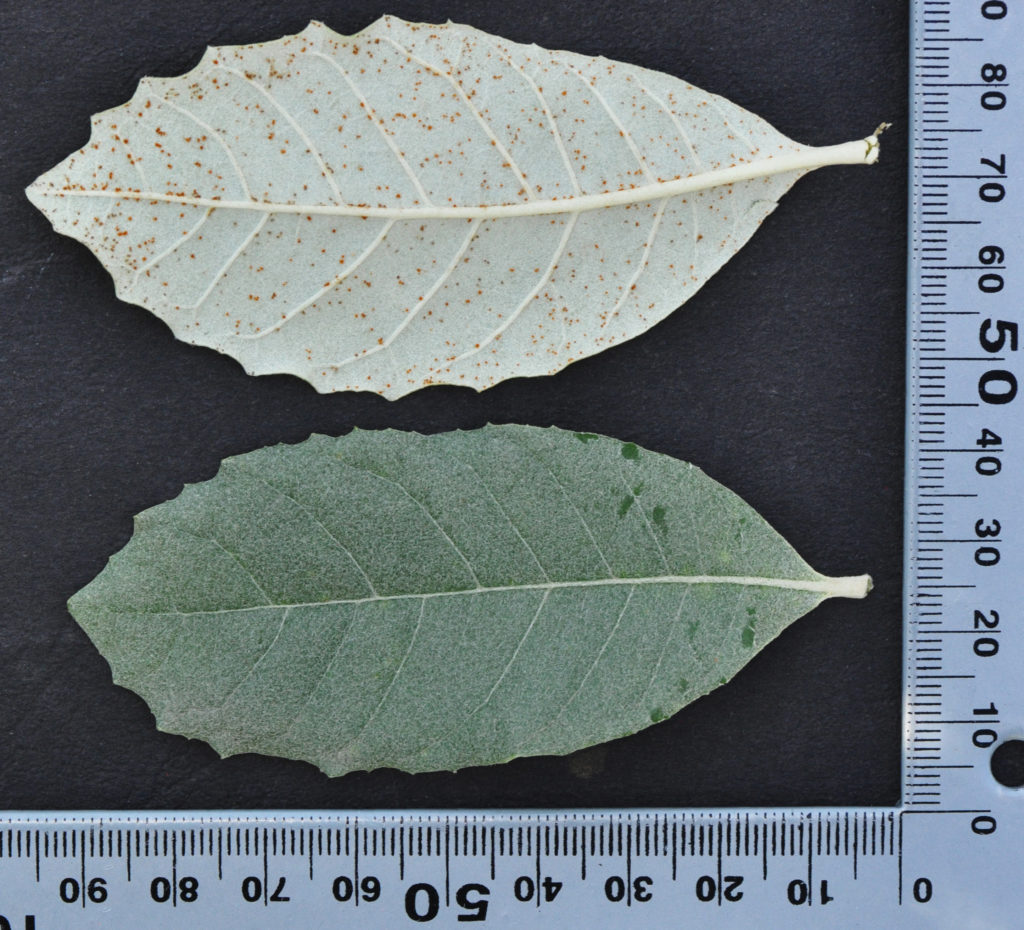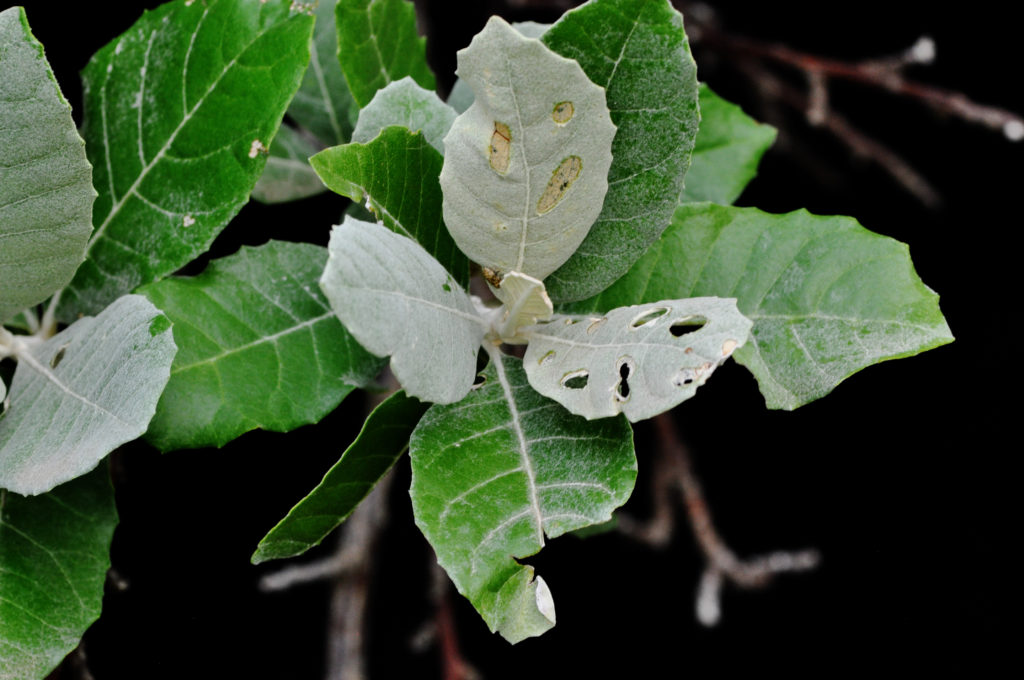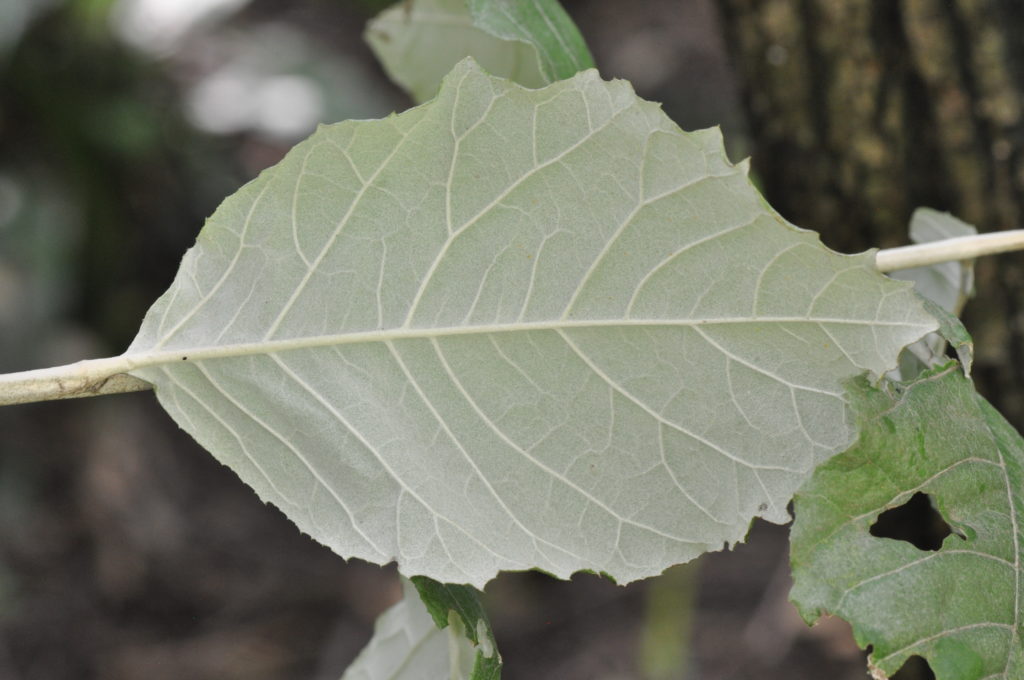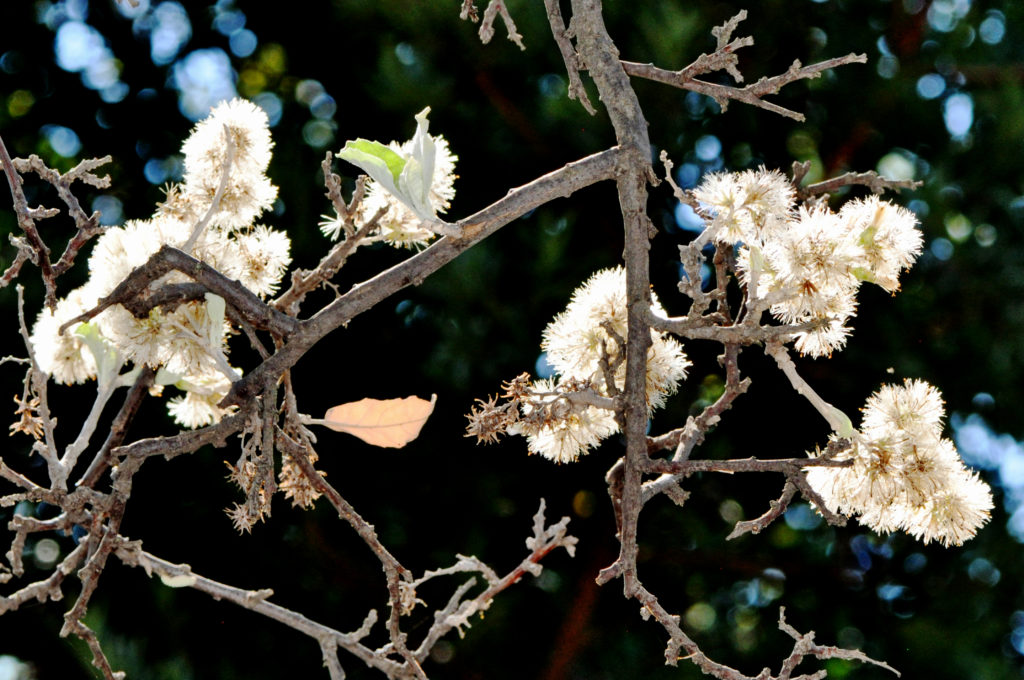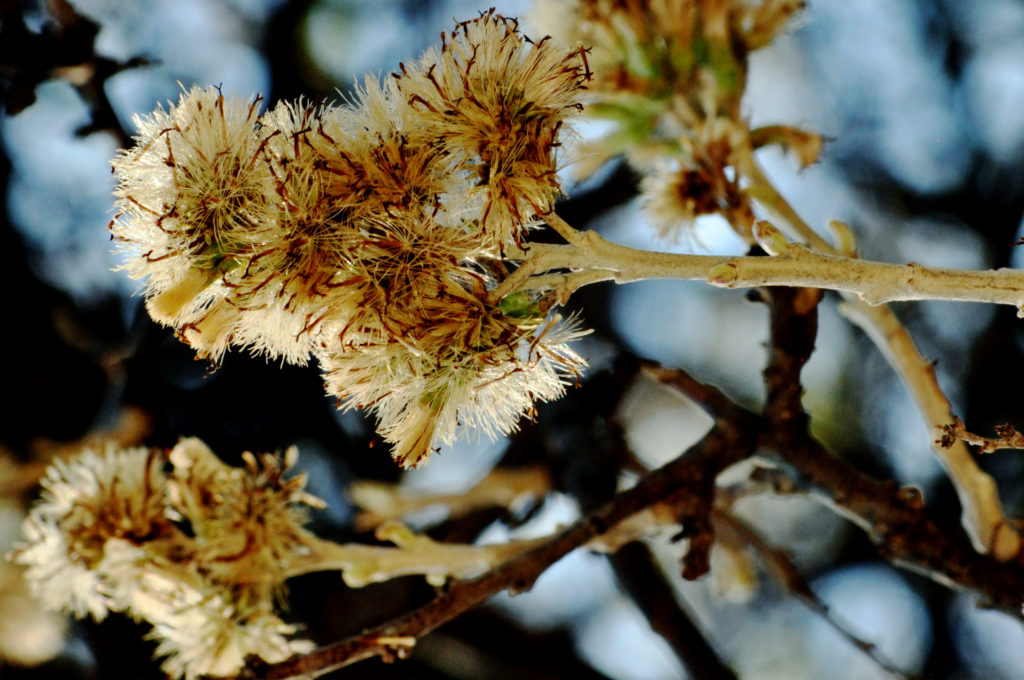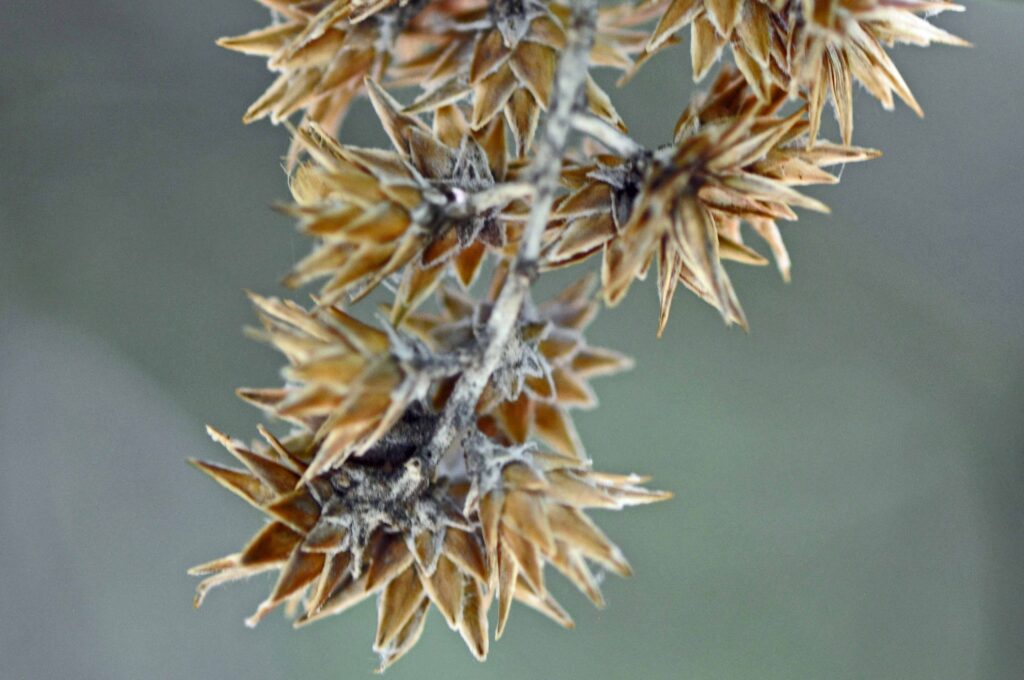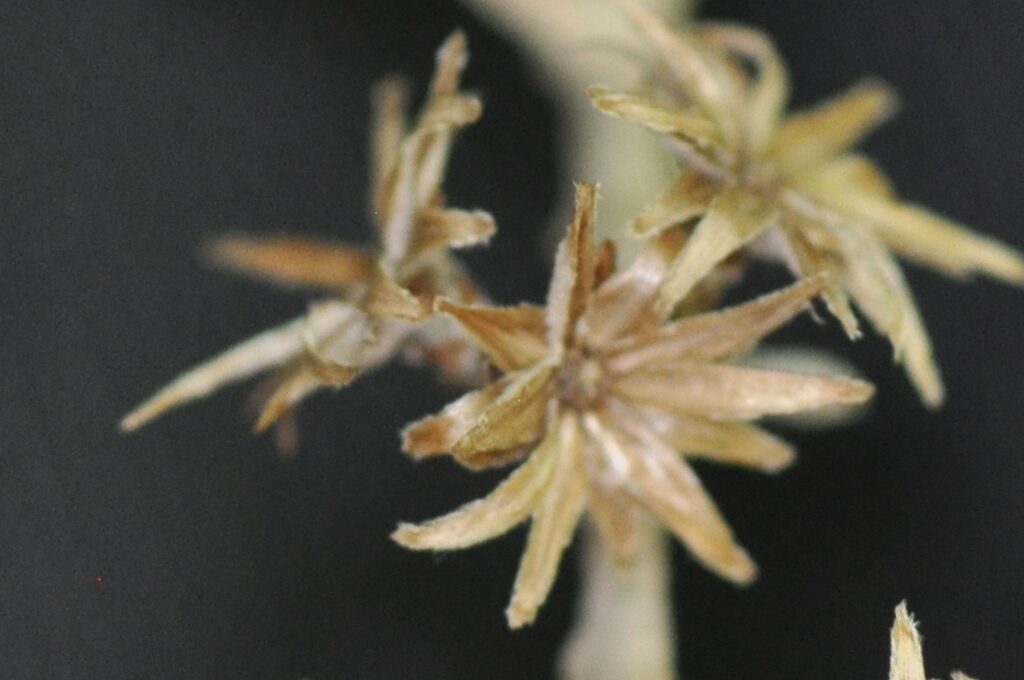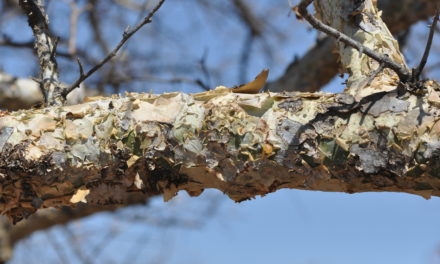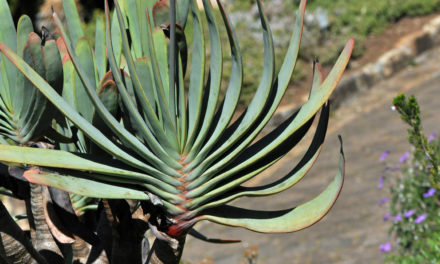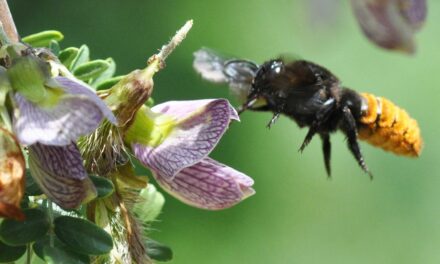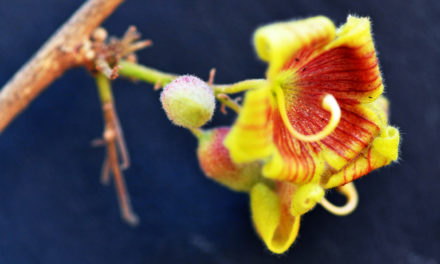General Info – summary
This Tree is up to 8m high and trunk to 20cm wide. Bark becomes dark and deeply grooved. Alternate Leaves are simple and up to 15x6cm. Dioecious trees have capitula with the small yellow Florets contained within a panicle. Male florets with 5 anthers, female florets with one pistil, inferior ovary and an exserted style. The Fruit is a cypsela. Pappus with an apical tuft of bristles for the wind dispersal of seeds.
Description
Brachylaena rotundata
Previous Names: Brachylaena discolour var. rotundata, Brachylaena rhodesiana.
SA Tree No. 730.
Common names: (Afr) Bosvaalbos, Bergvaalboom. (Eng) Highveld Silver-oak, Mountain Silver Oak, Mountain Silver-oak, Yellow Silver-oak.
Family Asteraceae, Compositae. (Daisy family: includes sunflowers, lettuce, chicory, marigolds). There are in excess of 1 900 genera and close to 33 000 species. This is possibly the second biggest plant family. In southern Africa, there are 246 genera and about 2 300 species. Local genera containing trees on this website include Brachylaena, Oldenburgia and Tarchonanthus. Some members have flowers grouped in heads and the whole head may appear to be a single flower – like the “sunflower”. Surrounding each flower are bracts. Individual Flowers have sepals replaced by a pappus which may be bristle, plume, scale or awn like. Individual flowers are called Florets that may have 5 fused petals. The inferior Ovary contains one Ovule, and the Style has 2 lobes. In the Asteraceae the flowers are called florets. In all members, Central Florets / Disc Florets are present. In some members, excluding Brachylaena, Outer Florets / Ray Frorets are also present. These occur around the periphery and are usually long and brightly coloured (e.g., yellow outer florets in the sunflower).
Name derivation: Brachylaena – short cloak – referring to the short floral bracts. rotundata – with roundish leaves. Ray florets are absent in the genus Brachylaena.
Conservation: National Status: L C. (Least Concern). Assessed: 2005 (W. Foden and L. Potter).
Tree
This Tree may reach 8m high or it may develop as an untidy much-branched shrub. The Trunk has a diameter of up to 20cm. The plant is usually solitary or may develop in small groups and the often-low-down Branches (photo 506) tend to droop. The Bark is dark, blackish or brown-grey and deeply grooved when old (photo 896). The usually slender, smooth and grooved Twigs (1-year-old current branch segments) are initially covered with white hairs (photo 489) but slowly become purplish or reddish-brown and hairless. Here Leaf Scars are clearly visible, as are the pale, raised Lenticels (a usually raised corky oval or elongated area on the plant that allows the uncontrolled interchange of gases with the environment). They may run lengthwise (photo 180).
- 506 2018.01.24 Walter Sisulu NBG. Photo: David Becking.
- 656 2014.10.30 Pretoria NBG. Photo: David Becking.
- 896 2014.03.25 Walter Sisulu NBG. Photo: David Becking.
- 476 2014.10.28 Walter Sisulu NBG. Photo: David Becking.
- 180 2014.10.07 Walter Sisulu NBG Photo: David Becking.
- 489 2016.08.16 Walter Sisulu NBG. Photo: David Becking.
Leaves
The alternate, leathery, evergreen or semi-deciduous Leaves (photo 239) are narrowly elliptic/oblong-elliptic, ovate, oblanceolate (upside down egg) or oblong and up to 2-10 x 2,5-6cm (photo 597). They are larger on coppice shoots (thicket or grove of small trees or shrubs, especially one exposed to periodic burning, cutting or pruning). The tree may be deciduous – mainly dependent on the temperature. Rubbing the Upper surface of mature leaves exposes a glabrous (hairless) dark green colour. This dark green becomes more apparent on older leaves as hair is lost (photo 236). Soft hairs cover the much lighter Lower surface (photo 597). Here the protruding Midrib and the lateral Veins clearly visible forming a loose Y before reaching the margin (photo 569). Slightly red autumn colours may develop. The Apex is rounded to broadly tapering and may be toothed. It may be minutely mucronate (ending in a short, sharp abrupt hair-like tip). The Base tapers or is almost rounded. The variable Margin is often entire or roughly and irregularly toothed – especially away from the base (photo 569). The short, slightly swollen Petiole (leaf stalk) is up to 7mm long (photo 597).
- 239 2015/12/15 Walter Sisulu NBG. Photo: David Becking.
- 597 2015/04/14 Walter Sisulu NBG. Photo: David Becking.
- 236 2015/12/15 Walter Sisulu NBG. Photo: David Becking.
- 569 2014/03/06 Walter Sisulu NBG. Photo: David Becking.
Flowers
Flowers develop in Synflorescences (compound inflorescences). Here they are arranged in Panicles (indeterminately, branched inflorescence with stalked flowers (photo 653). Within the synflorescence, each smaller inflorescence is a Capitulum (a false flower containing a dense cluster of many small, drab yellow Florets (individual Flowers mainly in Asteraceae and grasses). These yellow Florets may precede the new leaves. Individual florets have Sepals replaced by a Pappus (modified calyx – with bristles). The florets usually have 5 fused Petals. There are 5-8 whorls of small overlapping Bracts (usually much-reduced specialised leaves). These occur just below each floret (photos 40 & 45 – under Fruit). These photos show the bracts that remain after seed dispersal and loss of florets.
The capitula collectively form in a Panicle (an indeterminately, branched inflorescence with stalked flowers (photo 653) that is between 4 and 40cm long. They may be shorter when occurring in axils of fallen leaves. Each capitulum (photo 654) is about 1cm long and supported by a single Peduncle (stalk of flower cluster – photo 45 under Fruit) and a single, short Pedicel (stalk of a single floret) supports each Floret. In photo 654, a visible Peduncle (stalk of flower cluster) supports each capitulum. Here the Involucre (whorls of visible, initially green bracts) are in 5-8 rows. In photo 45 – under Fruit, the now clearly noticeable old bracts have aged from green to brown. In this photo, pedicels that supported each single floret are visible. The Sepals are replaced by a bristle-like Pappus (the modified calyx, the part of an individual floret that surrounds the base of the corolla tube in flower heads of the plant family Asteraceae). These are similar to a shaving brush when completely open (photo 653). The Corolla has a dull tube ending with 5 recurved, light yellow petal lobes.
This plant 1s dioecious (unisexual floral structures with functional male and female parts on separate plants). In each Male capitulum a dense cluster of 13 to 31 florets develop. Here the 5 Stamens are attached to the style and surround the Stigma. The Anthers are introrse (the line of dehiscence faces towards the flower centre). Here individual florets/flowers have an abortive Ovary. In the Female capitula), 11-27 florets develop. A single Pistil (a unit of the Gynoecium, the female element of the flower, composed of the Ovary, Style and Stigma) is present. The inferior Ovary has a single ovule, and the Style is exserted (sticking out) beyond the perianth (the 2 floral envelopes considered together; a collective term for the calyx and corolla) and ends with a Stigma with flat lobes that are ovate-lanceolate. Staminodes (sterile stamens) are absent. (Aug-Sep).
- 653 2014/10/30 Pretoria NBG. Photo: David Becking.
- 654 2014./10./30 Pretoria NBG. Photo: David Becking.
Fruit
Groups of fruit are small nutlets, tipped with creamy bristly hairs. In the photos below the remains of the whorls of small overlapping Bracts are visible.
- 45 2015/11/24 Walter Sisulu NBG. Photo: David Becking.
- 40 2015/11/24 Walter Sisulu NBG. Photo: David Becking.
Distribution & Ecology
This plant is Endemic (restricted to a particular geographic location) in southern Africa. It is common on rocky ridges, koppies, hills and occurs in open woodland, and bushveld. It may be associated with termite mounds and is often seen with Englerophytum magalismontanum (stamvrug). It is also found in inland forests and wooded grasslands. These plants are located in the Free State, Gauteng (e.g., Johannesburg, Pretoria, and Magaliesberg), Mpumalanga, Limpopo, North West, Botswana, Mozambique, Zimbabwe and Zambia. Flowers attract bees and flies.
Ethnobotany
The Tree is hardy, fast growing and transplants well. The creamy-brown Wood is strong and sought after for tool, axe handles and carving, but beyond this is not large enough to be of a useful size. (It has similar properties to those of the Ash – Fraxinus sp. in family Oleaceae).
References
Burrows, J.E., Burrows, S.M., Lotter, M.C. & Schmidt, E. 2018. Trees and Shrubs Mozambique. Publishing Print Matters (Pty) Ltd. Noordhoek, Cape Town. 2018.
Coates Palgrave, M. 2002. Keith Coates Palgrave Trees of Southern Africa, edn 3. Struik, Cape Town.
Foden, W. & Potter, L. 2005. Brachylaena rotundata S.Moore. National Assessment: Red List of South African Plants version 2020.1. Accessed on 2022/12/29.
Lawrence, G. H. M, 1951. Taxonomy of Vascular Plants. The Macmillan Company, New York. Tenth Printing 1965.
Palmer, E. & Pitman, N. 1972. Trees of southern Africa. Balkema, Amsterdam, Cape Town.
Schmidt, S. Lotter, M. & McCleland, W. 2002. Trees and Shrubs of Mpumalanga and the Kruger National Park. Jacana, Johannesburg.
van Wyk, B. & van Wyk, P. 1997 Field guide to Trees of Southern Africa. Struik, Cape Town.
http://www.greenplanet.co.za/plant/Brachylaena-rotundata
https://en.wikipedia.org/wiki/Brachylaena_rotundata
http://www.mk.org.za/mkflora.htm
file:///C:/Users/Probook/Downloads/800-1861-1-SM.pdf
http://posa.sanbi.org/flora/browse.php?src=SP

